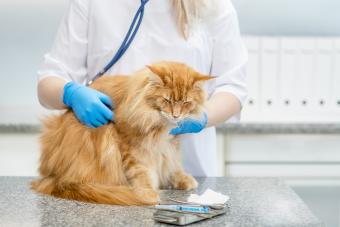
Feline hot spots are also known as acute moist dermatitis. These painful patches of skin infection require veterinary attention and are the result of the cat biting or licking excessively. In addition to treating the hot spot, the original cause of skin irritation should be identified and corrected, to prevent further flare-ups.
What Are Hot Spots?
A hot spot is the popular term for an infected skin sore. These sores usually appear when a cat has been biting and scratching at an irritating spot. If the skin is broken, bacteria normally present on the skin's surface have the opportunity to invade the scratch and cause an infection. The area becomes red and warm to the touch, hence the name "hot spot." As the infection progresses, the spot loses hair, begins to weep pus and eventually crusts over. The area remains irritated and itchy, and this results in even more scratching and biting that winds up making the sore even bigger.
Common Causes of Hot Spots on Cat's Skin
There are several potential causes of your cat's hot spots.
Parasitic Infestations
A hot spot is not a diagnosis, but a symptom. Your vet will look for the underlying cause of irritation which triggered the licking or biting. One of the most common causes of hot spots is fleas. Flea saliva acts like an allergen, triggering the release of inflammatory chemicals in the skin which cause itching. You might compare the condition to getting a mosquito bite and the maddening itchy feeling it gives you. A cat scratching with her claws soon breaks the skin and triggers a hot spot. Other signs fleas may be the problem include the presence of flea dirt and tens of small scabs spread over the cat's skin. While fleas are the most common cause, other biting insects, such as mosquitoes, can trigger an allergic reaction.
Environmental Allergies
As Vetary explains, cats can be allergic to many things in their environment, from natural things like dust mites to man-made chemicals such as air fresheners. Molds, pollen, grass, cleaning products and even the chemicals commonly found in carpeting can produce an allergic reaction in some felines and causes severe itching.
Food Allergies
If your cat's hot spots are not caused by any of the other potential reasons, a food allergy may be the culprit. Typically, a food allergy causes breakouts of crusting and scabbing over the head or body. Lab tests are notoriously unreliable as a means of diagnosing food allergies, so your vet may put the cat on a dietary trial. This involves feeding your feline a novel source of protein (a meat the cat has never eaten before) for around 8 - 12 weeks. If her symptoms disappear, then she is likely to have a food allergy.
For more digestive health information and guidance based on symptoms, get a copy of LoveToKnow's eBook "Happy Tummy Cat", which is written by a veterinarian and provides a great map of overlapping symptoms and underlying health issues for your cat.
Lack of Proper Grooming
Long-haired cats tend to experience hot spots more often than short-haired cats. A thick coat will interfere with air circulation around the wound, setting up a warm, moist environment for bacterial growth. Likewise, matted fur can also aggravate hot spots.
Treatment for Cat Hot Spots

Treatment is a two-faceted process of doctoring the wound and eliminating the underlying cause.
Detecting Parasites
Even if fleas are not seen at the time of the exam, their presence can be detected by finding flea dirt on your pet's coat. Flea dirt looks like pepper flecks on your cat's skin. If you aren't sure if the specks are dust or flea dirt, place some on a piece of damp cotton wool. The dry blood in flea dirt will hydrate in contact with water, resulting in a rust-colored halo around the speck. Since fleas and flea saliva are one of the most common allergens, your vet will suggest using a safe, effective flea product on all untreated cats.
Determining Allergies
If there is no sign of a parasitic, your vet may decide to test for environmental allergies or food allergies. Diagnosing allergies is difficult in cats, even with skin patch testing. If the allergen can be identified, the next step is limiting your pet's exposure to it. However, many times a compromise is needed, where instead of complete avoidance of the allergen, the cat receives a low dose of an anti-inflammatory medication (such as a corticosteroid) during the seasons when her allergy flares up.
Cleaning the Cat's Hot Spot Wound
To speed healing, your veterinarian will need to clip the fur around the hot spots. The vet uses clippers or curved scissors to trim hair from around the area to improve access to clean the hot spot and allow for better air circulation. Topical ointments and oral antibiotics may both be used to heal the wound. These commonly contain a combination of antibiotics (to treat the infection) and anti-inflammatories (to soothe the soreness). Most uncomplicated hot spots settle down with seven to fourteen days of treatment.
In extreme cases, the cat may need to wear an Elizabethan collar to prevent ongoing self-trauma to the hot spot. However, this is often distressing to the cat so the vet may give a low dose of a short-acting steroid in order to remove the tingle from the skin so the cat is more likely to leave it alone. In addition, if the infection has reached deeper layers of the skin, your cat may need oral antibiotics instead of a topical ointment.
Treating Hot Spots at Home
The principle of treating a hot spot is to allow air to the area and to keep the skin clean.
- Carefully trim away fur so that the hot spot is exposed to the air, which helps to dry it up.
- Bathe your cat twice a day with dilute salt water (one teaspoon of salt to one pint of cooled, boiled water). This acts as a mild disinfectant.
- Soak a cotton ball in the salt water and clean away any sticky discharge.
- Avoid using thick creams, such as Sudocrem, as these tend to seal infection in and prevent air getting to the skin.
Many hot spots do require at least a topical antibiotic. If your cat is prone to hot spots, ask your vet if they can supply an appropriate medicated ointment to have ready and waiting at home. Prompt treatment when the hot spot is first noticed, can stop it flaring into a much larger area. In addition, be conscientious about controlling parasites, such as fleas, to prevent skin irritation.
Preventing Hot Spots
Prevention, of course, is the best course of action, especially with such an uncomfortable condition like hot spots. If fleas caused the hot spots, your veterinarian will likely recommend a flea preventive. There are many effective products to choose from but be sure to apply regularly as per the manufacturer's instructions. In addition, treat all the pets in the house and use an environmental product to kill the eggs and larvae of the next generation of fleas.
If you have a long-haired cat, you may want to comb her coat daily. This will prevent mats from forming. You can also detect a potential problem before it gets out of hand. This plan is wise advice in any case because you may also be able to identify a flea problem and take quick action. Also, clip your cat's claws every two weeks, so those nails are less likely to do damage should the cat scratch.
Keep Your Cat Free From Hot Spots
Fortunately, you can treat and prevent hot spots easily once a cause has been identified. In this way, you can improve your pet's quality of life and keep her comfortable and itch free.







